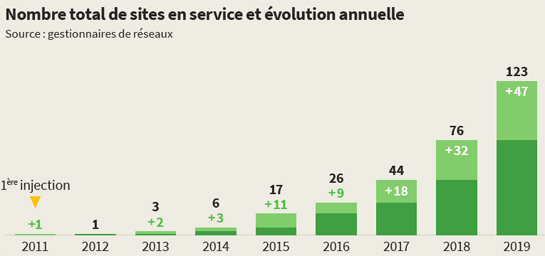Renewable Gas Panorama 2019
GRDF, GRTgaz, the French Renewable Energies Union (SER), the Professional Union of Non-Nationalised Gas Companies (SPEGNN) and Teréga are publishing the fifth edition of the Renewable Gas Panorama - an annual overview of a fast-growing renewable sector that almost doubled in size between 2018 and 2019.
The quantity of renewable gas injected into the networks went over the TWh threshold in 2019
Biomethane injection has seen strong growth for more than five years. 2019 confirms this trend with the commissioning of 47 new sites in France, bringing the number of facilities connected to French gas networks to 123 at end-2019. Once again, the quantities of biomethane injected into the networks almost doubled compared to 2018, crossing the symbolic mark in terms of TWh to reach 1,235 Gwh11 - the equivalent of the annual consumption of nearly 103,000 homes. The maximum annual injection capacity for all production sites reached 2,157 GWh at end-2019, versus 1,206 GWh at end-2018.

Multiple solutions to increase the attractiveness of the regions
Green gas injection provides a response to climate, socio-economic and agroeconomic challenges. In particular, it plays a role in the circular economy. The biomethane sector provides many regional services, including local waste recovery, resilience of farming operations, decarbonisation of the energy and agricultural sectors, digestate being returned to the ground as a natural fertilizer, and the creation of local jobs. The upskilling of value chain players and the structuring and professionalisation of the sector led to more than 4,000 direct and indirect jobs in 2018, with a turnover of €695 million2. On its own, the biomethane sector creates an average of three to four local jobs per facility, solely in the areas of operations and maintenance, which cannot be outsourced. In addition, renewable gas contributes to France’s energy independence with the sustainable production of a renewable energy that can be stored in the networks and produced close to consumption areas.
A sector that can be mobilised to support sectors weakened by the pandemic
Biomethane has a role to play in the French economy’s recovery plans in response to the current health and economic crisis. It aligns perfectly with societal expectations and is attuned to issues that are more topical than ever:
- contributing to carbon neutrality,
- supporting sustainable agriculture,
- preserving biodiversity,
- recovering regional waste (agricultural, household, industrial, agri-food, etc.),
- striving for energy independence,
- revitalising rural areas in all regions of France,
- revitalising a French-European industrial sector (100% European added value and 85% French).
The projects on record up to 2019 would enable France to achieve, or even exceed, the French Energy Code’s stated target of 10% renewable gas by 2030, and contribute to achieving carbon neutrality by 2050.
Of these, projects at an advanced stage represent more than 10 TWh/year of potential capacity. These mature projects can be mobilised as part of the recovery plan providing short-term economic support for weakened sectors, in particular agriculture and public works, in rural areas by 2023.
A few one-off support measures will be necessary for the projects’ full involvement in the economic recovery. First of all, the current support framework for mature biomethane projects must be strengthened, and the Multiannual Energy Programme targets increased accordingly to 12 TWh/year. The adaptation of the gas networks should be brought forward to accommodate the quantities of biomethane needed for the projects to proceed in the best conditions, and to aid the recovery by investing in strengthening the networks.
Longer-term prospects must likewise be provided to support the sector and strengthen the involvement of funders. Reforms to guarantees of origin and the future support framework, based on a balance between the revised purchase price and calls for tender, must be implemented in consultation with the sector. Calls for projects for uninjected biomethane and innovative biogas sectors (self-consumption, pyro-gasification, anaerobic digestion – methanation coupling, etc.) must be launched following the adoption of the related mobility and energy-climate laws.
Finally, work on the environmental, economic and agronomic benefits brought about by the development of the sector (assessed as up to €70/MWh3 of value creation4 5) should also be included in the future support framework.
All renewable gas sector stakeholders are called upon to help implement the French economy’s recovery plan supporting the circular economy, carbon neutrality, sustainable agriculture and respect for biodiversity.
1 1 TWh = 1,000 GWh = 1,000,000 MWh = 1,000,000,000 kWh = equivalent to the average consumption of 80,000 households.
2 Based on the adaptation of the Ecological Employment & Territories Transition (TETE) tool developed by the Action Climat France network and the French Environment and Energy Management Agency (ADEME) with the contribution of Philippe Quirion, January 2018 (https://territoires-emplois.org). Turnover includes investment, operations and maintenance of anaerobic digestion units.
3 ENEA study "Increasing the competitiveness of the French biomethane sector: many potential short- and medium-term levers", October 2018
4 Data from the Prospective Committee of the Energy Regulation Commission
5 Report on Gas Greening, Prospective Committee of the Energy Regulation Commission, 2019.